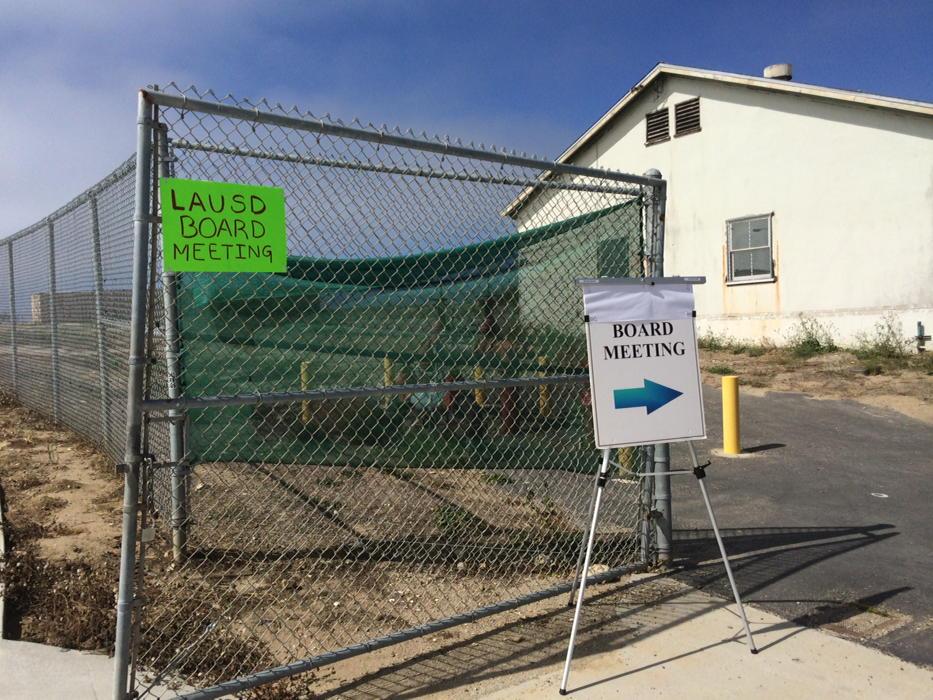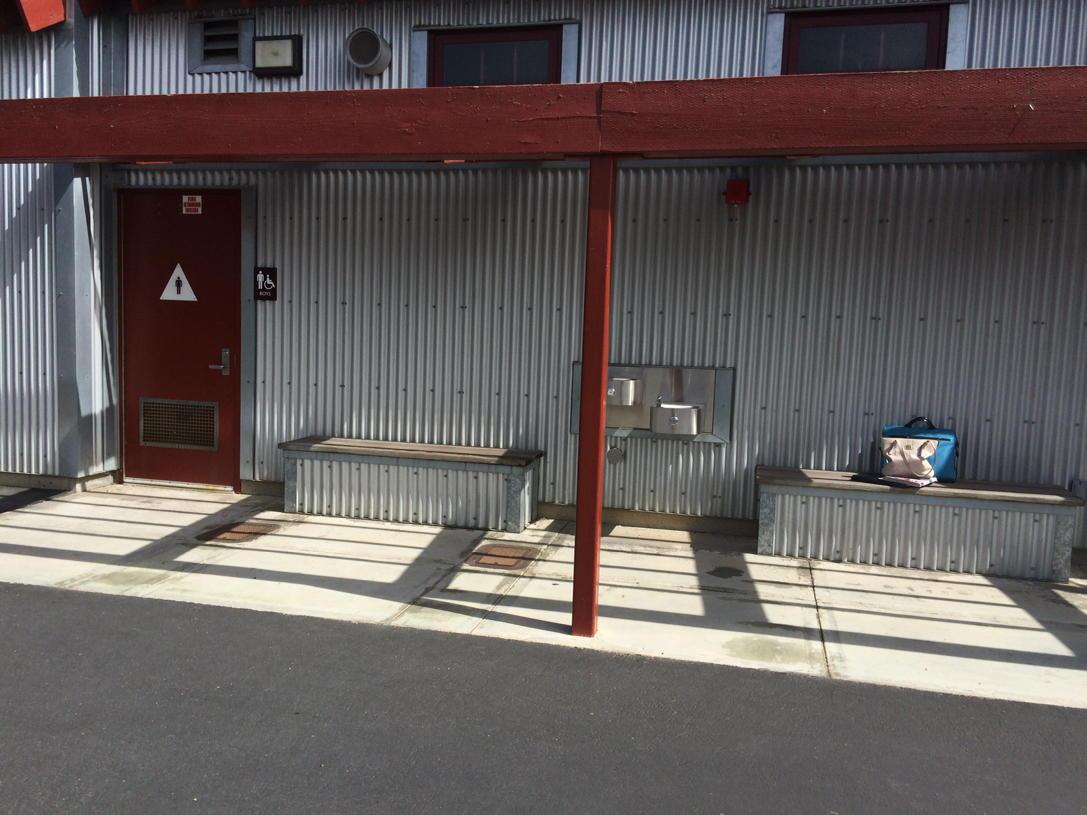
Credit: LA School Report | Gov. Jerry Brown campaigns for passage of the Local Control Funding Formula during an appearance in Los Angeles.
Aug 27, 2015 | Though far from a majority, an increasing number of Californians say that the state’s public schools have gotten better over the past few years, according to a poll released on Thursday.
But it’s not because they are impressed with the sweeping changes in managing and financing K-12 schools. Two-thirds of those surveyed said they had never heard anything about the Local Control Funding Formula, the new funding and governance law that the Legislature passed two years ago.
These are among the findings in the latest annual joint poll of 2,411 registered voters, including 688 parents of K-12 students, conducted this month on behalf of the University of Southern California Rossier School of Education and Policy Analysis for California Education, or PACE. Participants were chosen to reflect the state’s demographics, and interviews were conducted in Spanish or English. (Go here for more details on the methodology.)
The poll also found widespread support for renewing Proposition 30, the temporary quarter-cent increase in the sales tax and increases in income taxes on the wealthiest 1 percent of Californians, which has brought in an average of $6 billion yearly for K-12 schools and community colleges. And it found that more Californians approved of Gov. Jerry Brown’s handling of education (45 percent) than disapproved (38 percent), a slightly higher margin than in 2012, the first year of the survey.
Local Control Funding Formula
The 65 percent of all respondents (56 percent of K-12 parents) who said they had never heard or read about the new funding law in the previous six months was significantly higher than a year ago, when 45 percent of the total said they hadn’t heard or read about it.
David Plank, PACE’s executive director, speculated that the new law was more in the news last year, the first year of its rollout.
The shift to local control – a key reform under the funding formula – assumes that the public will become engaged in the process of setting priorities over spending. But just 9 percent of K-12 parents and only 4 percent of respondents overall said they had been invited to or made aware of a meeting regarding the Local Control Funding Formula.
“To have such low levels of awareness and participation after two years of LCFF implementation is alarming,” said Julie Marsh, USC associate professor and PACE co-director.
Plank said, “The great promise of (the funding law) is it would change the conversation to innovate and experiment at the local level. We created a space to engage a much broader community, but unless there are new actors, then we will continue to have the same conversations over again.”

USC Rossier School of Education/PACE
Fewer respondents to the poll reported hearing anything about the new funding formula this year, compared with a year ago.
Of voters familiar with the Local Control Funding Formula, 54 percent had a positive view of it, and 22 percent viewed it negatively. Among parents, the view was 54 percent positive and 14 percent negative, with the rest saying they weren’t sure or didn’t know. And when read a summary of the intent of the law, 80 percent of all respondents agreed that it was important to involve the community in making decisions.
The survey did not specifically ask voters whether they were involved with the Local Control and Accountability Plans, or LCAPs, in which districts set spending priorities and academic and education goals. It’s possible that some of those surveyed were familiar with the new funding law under a different name, Plank acknowledged.
Perceptions of schools
According to the survey, 17 percent of voters said that schools have gotten better, which was 10 percentage points higher than in 2012. The number who said schools had gotten worse fell significantly, from 57 percent in 2012 to 39 percent this year. The rest said they remained the same or had no opinion (9 percent).
Plank speculated that the latest numbers reflect a decline in bad news. In the years following the most recent recession, headlines were all about massive cuts in funding and staff layoffs. Now, finances have stabilized, he said, “and some people are beginning to sense that things also genuinely are getting better.”
Asked to grade California schools:
- 18 percent of voters gave schools an A or B, compared with 15 percent in 2012, when schools were still experiencing cuts;
- 43 percent gave schools a C, compared with 36 percent in 2012;
- 32 percent gave schools a D or F, compared with 42 percent in 2012;
- 7 percent had no opinion, the same percentage as in 2012.
Respondents gave their own schools higher grades, which is consistent with other surveys:
- 34 percent gave an A or B, compared with 31 percent in 2012;
- 33 percent gave a C, compared with 37 percent in 2012;
- 21 percent gave a D or F, the same percentage as in 2012;
- 12 had no opinion, compared with 11 percent in 2012.
School funding
Even though many schools have recovered from cuts following the recession, with an average 30 percent increase in spending over the past three years, few respondents said they’ve seen money coming to schools.
- A third of the total (30 percent of K-12 parents) said schools have had at least a little more money in the classroom;
- 26 percent of all respondents said it’s about the same;
- 26 percent of all respondents (32 percent of K-12 voters) said there was less money;
- 16 percent were unsure.
A majority of all respondents (60 percent) and K-12 parents specifically (74 percent) said that schools remain underfunded, and the state should be paying more. By party affiliation, 73 percent of Democrats said there should be more money for schools, compared with 47 percent of Republicans and 55 percent of independent voters.
With the sales tax increase under Prop. 30 set to expire in 2016 and the income tax increase to end in 2018, 63 percent of all respondents and two-thirds of K-12 parents favored extending it in some form – a position opposed at this point by Gov. Brown.
- 29 percent of all respondents and 28 percent of K-12 parents supported extending both taxes;
- 26 percent of all respondents supported extending
- 8 percent of all respondents and 12 percent of K-12 parents supported extending the sales tax but not the income tax;
- 28 percent of all respondents and 22 percent of K-12 parents said both taxes should end;
- 9 percent of all respondents and 12 percent of K-12 parents were unsure.
Among Democrats, 78 percent favored some form of an extension, while only 42 percent of Republicans did; Independents fell in between, at 63 percent.
Support for renewing Prop. 30 was stronger than it was in two previous polls by the Public Policy Institute of California. Its survey of likely voters in January 2015 and December 2014 found 52 percent favored an extension and 43 percent opposed.
MFour Research and Tulchin Research conducted the poll. The margin of error was 2.9 percent.
_______________________
California voters back extending Proposition 30 to funnel more money to public schools
PACE/USC Rossier Poll shows voters have little knowledge of Local Control Funding Formula reform meant to dramatically alter public school finance and accountability in the state
Policy Analysis for California Education | http://bit.ly/1KSxhS2
Contact: Merrill Balassone at balasson@usc.edu or (213) 740-6156
08/27/2015 | LOS ANGELES – August 27, 2015 – As optimism about the state of California’s public schools continues to rise, a strong majority of California voters would back the reauthorization of Proposition 30 to channel additional money to public campuses, according to a new poll released Thursday.
The PACE/USC Rossier School of Education Poll shows 63 percent of voters are in favor of extending at least one provision of Prop. 30 – the tax increase on high incomes or the sales tax hike or both – that is set to expire at the end of 2016. Only 28 percent of voters said both fiscal provisions should be allowed to expire, the poll showed.
Approved by the voters in 2012, Prop. 30 temporarily increased the state sales tax by a quarter cent and the personal income tax rate on people earning more than $250,000 a year to fund public education and other government programs.
Six in 10 voters said California should be spending more on schools, as opposed to 26 percent who said the state’s public schools have enough money, the poll showed.
“Since the inception of this poll in 2012, we have identified valuable trends that not only reflect the opinions of the state’s voters but also influence policymakers in Sacramento,” said USC Rossier School Dean Karen Symms Gallagher. “The latest results indicate a growing confidence in our public school system as voters are clearly willing to provide greater financial support to education."
Voters were comparatively less enthusiastic about proposed changes to Proposition 13, which sets limits on property taxes. Changing the rules on the taxation of business and commercial property would raise an estimated $6 billion to $10 billion per year, of which 40 percent would go to public schools. A slight majority of voters – 51 percent – said they would support changes to Prop. 13, as compared to 39 percent who would oppose it.
“Although voters want more invested in education, we don’t see an underlying appetite for more extreme measures, such as making changes to Prop. 13,” said Jeff Harrelson, chief operating officer of Republican polling firm MFour Mobile Research, part of the bipartisan team with Democratic polling firm Tulchin Research that conducted the PACE/USC Rossier Poll. “Policy makers should be prepared to engage in an extended voter education effort on this issue."
Said Ben Tulchin, president of Democratic polling firm Tulchin Research: “Voters believe California’s public schools have made some progress over the last few years. As a result, a large majority of California voters wants to extend Proposition 30, particularly its tax on the wealthy, in order to continue this progress.”
California voters have become less pessimistic about the state of their public schools. Between 2012, when the question was first asked, and 2015, the percentage of voters who say the state’s public schools have gotten better more than doubled, from 7 percent to 17 percent. During that same time period, the percentage of voters who said public schools were getting worse declined, from 57 percent to 39 percent. Thirty-six percent of voters said public schools had stayed the same.
When asked about their neighborhood public schools, 17 percent of California voters said they had gotten better, up from 11 percent in 2012. Thirty-four percent of voters said their local public schools had gotten worse, down from 45 percent in 2012. Thirty-eight percent of voters said local public schools had stayed the same.
“Voters are clearly not satisfied with the state of California’s public education system, but they are beginning to see their schools moving in the right direction,” said David Plank, executive director of PACE. "They still see a lot of room for improvement, but this is a very encouraging trend.”
Lack of awareness of Local Control Funding Formula “alarming”
Sixty-five percent of California voters said they have never heard or read about the Local Control Funding Formula, or LCFF, Gov. Jerry Brown’s 2013 reform under which billions of dollars have been funneled to school districts to directly help English learners, foster children and students from low-income families, and an additional 21 percent said they had not heard or read much about it, the poll showed. Only 14 percent of voters said they had heard or read a little or a great deal about the LCFF.
When given basic information about the new funding formula, 57 percent said they approved of the policy, while 22 percent said they opposed it.
The new LCFF policy requires school districts to work with their local communities to develop accountability plans and decide on the allocation of funds, but just 4 percent of voters said they had been invited to or made aware of a meeting regarding LCFF. Eighty-seven percent of California voters said they were not invited or made aware of meetings related to deciding how schools should spend funds, the poll showed.
Among parents, 76 percent said they had not been invited to or made aware of a planning meeting, while 9 percent said they had.
“To have such low levels of awareness and participation after two years of LCFF implementation is alarming,” said Julie Marsh, USC associate professor and PACE co-director. “California’s new accountability system under LCFF depends on broad public engagement and an expectation that the usual suspects are not driving decisions. The overwhelming majority of voters endorse public participation, but we’ll have to do a lot more to bring them into the process.”
Those California voters who had heard "a good deal or a little" about LCFF were more likely than those who were unaware of the new funding policy to be engaged already with their schools in other ways. Voters who were aware of LCFF were nearly twice as likely to vote in school board elections (38%) as those who were unaware (20%), and more than four times as likely to be members of a PTA (29% versus 7%).
Nearly 8 in 10 voters (79%) said they thought it was important for parents and community members to be involved in the LCFF process, as opposed to 10 percent who thought it was unimportant, according to the poll.
While LCFF intends to broaden the measures by which school are held accountable to include more than performance on state tests, voters appear to still greatly value student achievement measures above all others. When asked about the eight state priorities for which schools are accountable under the new LCFF policy, voters were most likely to rank student achievement as the most important (29%); followed by provision of basic services as measured by, for example, the condition of school facilities (16%); and student engagement using measures such as school attendance (14%). School climate, implementation of Common Core State Standards and course access were the least likely to be ranked by voters as most important.
Approval ratings on education rise for Brown, but CA schools earn middling grades
A plurality of voters said they approved of the job Gov. Brown is doing on education, with 45 percent who approve as compared to 38 percent who disapprove - the highest approval rating since the PACE/USC Rossier Poll first asked this question in 2013.
Forty-six percent of voters said they approve of the job President Obama was doing on U.S. education issues, as compared to 41 percent who disapprove.
The PACE/USC Rossier Poll also showed that Californians continue to give the state’s public schools average grades, although fewer voters believe schools are failing.
The largest percentage of Californians (43%) gave their state’s schools a grade of “C.” And 32 percent of voters graded them a “D” or “F,” down from 42 percent in 2012.
Twenty-one percent of voters gave their local public schools a “D” or “F” rating, down from 32 percent in 2012.
When asked to rank the state’s public schools on specific measures of performance, on a scale of 0 (worst) to 10 (best), Californians gave the best mean score – 5.24 – to “teaching the basics of reading, writing and math.” The next highest marks came for “preparing students for a four-year university” (4.9) and “providing parents with a choice of public schools to send their child” (4.74). The lowest was “not spending too much on bureaucracy” (3.98).
The PACE/USC Rossier School of Education Poll was conducted August 3-22, 2015 by polling firms MFour Mobile Research and Tulchin Research and surveyed 2,411 registered California voters. The poll was conducted online and allowed respondents to complete the survey on a desktop or laptop computer, tablet or smartphone. The poll was conducted in English and Spanish. The margin of error for the overall sample was +/- 2.9 percentage points.
The poll is the fifth in a series from Policy Analysis for California Education (PACE) and the USC Rossier School of Education.
To view the results of the PACE/USC Rossier Poll, go to http://edpolicyinca.org/node/534
About the USC Rossier School of Education
The mission of the USC Rossier School of Education
(ross-EAR) is to improve learning in urban education locally, nationally and globally. USC Rossier leads the way in innovative, collaborative solutions to improve education outcomes. Their work is field-based, in the classroom, and online, and reflects a diversity of perspectives and experiences. USC Rossier prides itself on innovation in all its programs, preparing teachers, administrators, and educational leaders who are change agents. The school supports the most forward-thinking scholars and researchers, whose work is having direct impact on student success in K-12 schools and higher education. USC Rossier is a leader in using cutting-edge technology to scale up its quality programs for maximum impact.
About Policy Analysis for California Education (PACE)
Policy Analysis for California Education (PACE) is an independent, non-partisan research center based at Stanford University, the University of California – Berkeley and the University of Southern California. PACE seeks to define and sustain a long-term strategy for comprehensive policy reform and continuous improvement in performance at all levels of California’s education system, from early childhood to post-secondary education and training. PACE bridges the gap between research and policy, working with scholars from California’s leading universities and with state and local policymakers to increase the impact of academic research on educational policy in California.
Crosstab Topline Methodology Memo
 August 31, 2015 9:20 am :: The LA Unified school board made limited progress yesterday in the search for a new superintendent. The members invited two headhunter firms to pitch their ideas on how to handle the search but said three other firms may also still be in the running.
August 31, 2015 9:20 am :: The LA Unified school board made limited progress yesterday in the search for a new superintendent. The members invited two headhunter firms to pitch their ideas on how to handle the search but said three other firms may also still be in the running.
 Howard Blume
Howard Blume 



![eb37f5dc0f345f2f9b817a347c5f71d3_400x400[1] eb37f5dc0f345f2f9b817a347c5f71d3_400x400[1]](http://lh3.googleusercontent.com/-rWpFAvz9dMk/VeD3D0Ii5TI/AAAAAAAAKtk/9wgr9NvuKU8/eb37f5dc0f345f2f9b817a347c5f71d3_400x400%25255B1%25255D%25255B1%25255D.jpg?imgmax=800) Howard Blume
Howard Blume 






![LCFF-logo-179x179[1] LCFF-logo-179x179[1]](http://lh3.googleusercontent.com/-3bq1D_aZr90/VeC6AIoqRKI/AAAAAAAAKsM/mypSbTxBtU0/LCFFlogo179x1791_thumb2.jpg?imgmax=800)






